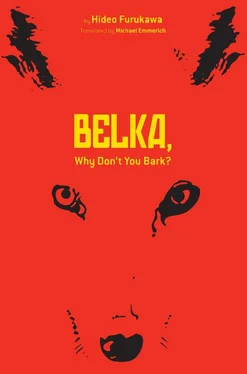Their insignia featured a skull.
Not a human skull. An animal skull. A dog’s skull.
A dog’s skull with the earth in the background.
That was the badge “S” used.
The earth was angled so that the north of the Eurasian continent was visible. So that this part of the globe faced the viewer, so that it was the front.
Every member of the unit had seen the skull on which the insignia was modeled. Once or twice, maybe three times, they had been granted an audience. There, in the room known as the Director’s Office, they had trembled with emotion at the sight. The real thing was preserved in a sort of casket shaped like the earth. In a globe specially constructed for that purpose. It was burned, blackened, little scraps of flesh clinging to it, hanging from it, here and there. Those were the traces that had been left when it was immolated on its reentry into Earth’s atmosphere, when the man-made satellite began to burn, to disintegrate. This was the skull of the first living creature from Earth to look down at the planet from outer space. These were the remains, in other words, of the space dog, the Russian laika, that had extended the reach of Soviet territory, of the homeland, into outer space.
“We will wage war against the counter-revolutionary movement and fight with the power of heroes—and of this hero! We are the embodiment of legitimacy!” The words reverberated through the Director’s Office.
It was never made clear how exactly the skull of this dog—once both a hero of the state and a popular idol—found its way into the Director’s hands. Because all information, even the most trivial, relating to the space dogs was classified as top secret. But the man who created “S” was closer than anyone else to those secrets. He had control of the space dogs’ bloodline. And he determined that nothing as insignificant as Khrushchev’s fall from power would derail the project, now that his posse at the breeding ground in South Siberia was unquestionably approaching the ideal. This project could not be allowed to die… this lineage could not be allowed to die. These dogs. This was where a master spy showed his true value as a master spy. And so, at the age of twenty-six and seven months, this young man who was expected to go far, who had been promoted within the KGB to the rank of lieutenant, responded to nonexistent expectations by contacting various branches of the KGB, trying this and that, working to realize a plan of his own. For the dogs… to guarantee their survival.
And one day a door opened, and out came the skull of the first space dog.
Someone told him Sputnik 2 wasn’t designed for recovery, so it had broken to pieces when it entered the atmosphere on May 14, 1958. Someone else insisted that the date had been April 4, not May 14, and the satellite burned up. One document, however, indicated that the wreckage of Sputnik 2 had in fact been recovered. The real thing, the secret document itself, remains in some KGB office. A copy is held, as well, in the secret vaults of the Council for the Memorial Museum of Cosmonautics. They may have been there from the beginning, or perhaps they found their way in at some later date. Either way, the documents are there.
And the door opened. The same door that opened to admit the wrecked cockpit of the MiG fighter Yuri Gagarin—the first human to fly in outer space, on the Vostok 1 in April 1961, known for his famous comment “The earth is blue”—had been riding in when he was killed in a mysterious crash in 1968. It opened, and out came the skull.
It was a real laika skull, from a mid-sized dog.
Documents proved that this was her skull.
“S” came into existence toward the end of the 1960s. It was a code-named unit under the administration of the KGB Border Guard Headquarters, but with its own authority. “S” had been inspired by Khrushchev’s dreamy romanticism, but the cheesiness of its origins had been eliminated, and it now had a rational basis for its existence. The involvement of that dog, the bitch who demonstrated to the world the greatness of the Soviet homeland, proved that we, “S,” were not just some group of renegades.
We were born of that event, on November 3, 1957—Marxism-Leninism’s single greatest achievement. We are its progeny.
“We are a corps centered on dogs, and it is our job to support our dogs,” the creator of “S” told his men. “We ourselves are the progeny of the bitch named Laika.”
So their legitimacy could never be in doubt.
And so, he said, pledge allegiance to the “S” insignia!
The men pledged their allegiance. They saluted the skull in its globe.
And so, when Gorbachev declared that perestroika was revolution in July 1986, the members of “S” could deny this without batting an eye, smiles on their faces. The revolution had already happened, in 1917, and we were its progeny—we, the members of “S.” Gorbachev’s statement was a joke. They knew it. But sometimes even words mumbled in sleep can alter the course of history. It doesn’t matter who is legitimate, who is the renegade.
The Afghan War continued. The two sides were in a stalemate, to put it simply, and it was slowly becoming apparent how closely this Central Asian quagmire resembled those ten years of war that America had initiated… America’s Southeast Asian quagmire. First there was the massive scale of the two conflicts—endless wars of attrition fought against guerrillas. Then there were all the other, smaller similarities. Young Soviet conscripts were destroying themselves with drugs. They smoked hashish the way young American conscripts had used LSD, heroin, and marijuana during the Vietnam War. Indiscriminant massacres were committed because it was impossible to tell civilians from guerrillas. During the Vietnam War, unspeakable tragedies had unfolded in villages the Americans regarded as Vietcong strongholds—everyone in these villages was slaughtered, from infants to the elderly; even domestic animals were shot; and naturally the women were raped—and now, in the same manner, villages the Soviets regarded as mujahideen strongholds were completely wiped out. Everyone in these villages was slaughtered, from infants to the elderly, even domestic animals were shot, and naturally the women were raped, gang-raped. Limited use was made of chemical weapons, albeit in secret. In the Vietnam War, the American army had done the same thing, in secret.
The Soviets were confronted with the fact that the Afghan War was “our Vietnam.”
And there was Gorbachev. There was Gorbachev, singing his slogan: Perestroika! Perestroika! He initiated a completely new foreign policy. Relations with the West would now be aimed at fostering dialogue, guided by the notion of “new thinking” diplomacy. Gorbachev was trying to change the direction of the Soviet-American arms race. The Soviet economy was stagnating. It had been subsiding into stagnation for some time, but Gorbachev was the first to acknowledge this. In fact, the USSR was on the verge of bankruptcy. He admitted it. And their enormous military expenditures were putting the most pressure on the treasury. One aim of Gorbachev’s “new thinking” diplomacy was to make it possible to cut the military budget. He pushed ahead with negotiations concerning nuclear non-proliferation, and finally he was able to improve relations not only with America, Britain, and France, but even with China. Red China—the third player in the Cold War. The whole shift was described by the term détente .
Something was changing.
Something was speeding up.
And then Gorbachev made the announcement: “Withdrawing troops from Afghanistan is also perestroika . ”
The United Nations had gotten involved in peace negotiations relating to the Afghanistan problem in 1982 but had failed to make any progress. In April 1988, with this statement by Gorbachev, everything happened in a flash: a peace accord was signed. Now it was settled. The Soviet army would withdraw from Afghanistan.
Читать дальше












